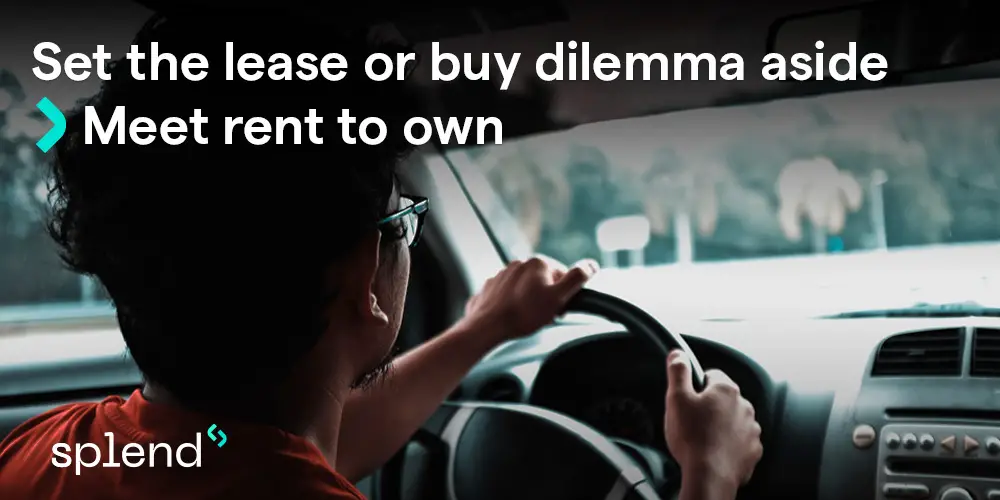
To lease or to buy? To some, it’s a no-brainer, but countless rideshare and Uber drivers lose many hours of sleep contemplating whether they should lease or finance their next car because they see compromises to both options. Especially, if all they get is high-interest quotes because of a poor credit score, or don’t qualify at all.
There is, however, a third way to get your hands on a car that few people ever talk about. Meet “Rent to Own”. Rent to Own is the happy medium many wish they knew about when they bought their current car.
We asked the specialists at vehicle solutions provider Splend to tell us more about this hybrid solution. Splend had their debut with rent to own cars in Australia in 2015, and have since conquered the London market with their successful product – the only difference being that they call it rent to buy cars in the UK.
So What is Rent to Own?
As the name suggests, Rent to Own combines the ease and flexibility of renting with the obvious benefits of long-term car ownership. It has a common theme with leasing as well, in that the car is not your liability for a few years, but imagine if they tried to squeeze that into the name too…
If you’re not 100% sold on the idea of car finance or leasing, rent to own might be a solution to consider.
How Does it Work?
Again, it’s exactly what the name suggests. You rent the car for an extended period of time (usually 3-4 years, which is comparable to a car finance or lease plan), but instead of saying goodbye to your money you cashed out in weekly payments, you get to keep the car at the end of your contract.
How is it Different from Leasing or Financing?
The main advantages of rent to own compared to financing or leasing are the lower barrier to entry and flexibility.
1. It’s more accessible – no credit check or full deposit
Since you’re always paying one week in advance, you don’t have to borrow money, therefore your credit score doesn’t matter.
You can apply even if you wouldn’t qualify for a lease or car finance, and you don’t have to pay a hefty deposit either.
That’s not to say that you have no upfront payment, though: in addition to the standard payment for the upcoming week you also have to pay a joining fee (covering the provider’s expenses to get your car ready, and your lifetime access to their dedicated Uber driver support and other ancillary services) plus the current week’s rent the first time you pick up your car.
Still, it’s nowhere near what you’d pay as a deposit and the additional fees and commissions associated with the credit-based alternatives…
2. It’s flexible – low commitment, similar to a rental
While most drivers obviously get into rent to own with ownership in mind, it’s still technically a rental. Therefore,
it doesn’t lock you in for years, so you can hand back the keys free of charge if life gets in the way, or you simply change your mind.
That thought alone should save you a few restless nights. The only commitment you make is to rent the car for at least 26 weeks, but you can change your mind sooner than that. They’ll just charge you for whatever is left of your minimum rental period.
It’s worth mentioning that for those who find the 26-week minimum too much, such as beginner Uber drivers who are not yet sure if on-demand driving is for them, Splend’s Uber car rental (known as PCO car hire in the UK) comes in at just a 4-week minimum and a lower joining fee, for the same level of support.
3. It takes less time – to get the car, as well as to repay it
With Rent to Own you save time. Not just because of the simplified initial procedure and the fact that you don’t have to waste precious hours doing paperwork, but also because you can shorten your term and gain full ownership of the car sooner.
The agreement includes a weekly driving allowance of 1,000 kilometres or 700 miles for the set weekly rental fee, with any mileage above that costing about 10 cents per mile. However, don’t think of these fees as a penalty – these sums bring forward your termination date.
Say, your weekly fee is $250 and you drive 100 miles more than your weekly allowance on average. This means you pay $10 extra per week. That adds up to a week’s rental every 25 weeks, or a little over two weeks’ worth in a year. This way you can shorten your Rent to own agreement by about 8 weeks over the normal 4-year span.
And the more you drive, the sooner you own the car.
